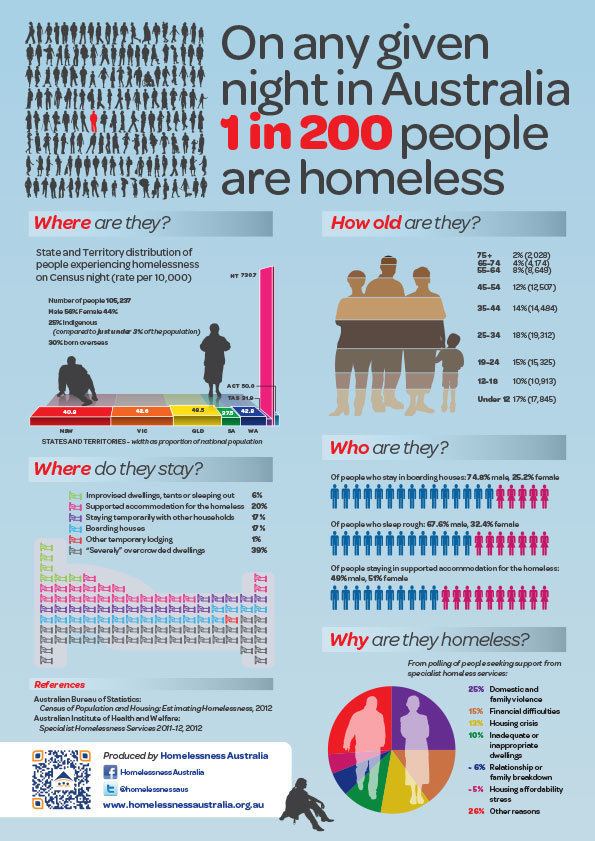 | ||
Homelessness in australia
Homelessness in Australia is a significant social issue. A majority of people experiencing homelessness long-term in Australia are found in the large cities of Sydney, Melbourne, Brisbane and Perth. It is estimated that on any given night approximately 105,000 people will be homeless and many more are living in insecure housing, "one step away from being homeless". A person who does not obtain any shelter is often described as sleeping 'rough'.
Contents
- Homelessness in australia
- 2011 census homelessness figures
- Causes
- Costs
- The Road Home Federal Government White Paper
- Affordable housing
- National Partnership Agreement on Homelessness NPAH
- State Government initiatives
- AskIzzy
- Youth homelessness
- Youth refuges
- Post traumatic stress disorder and homelessness
- Awareness days
- References
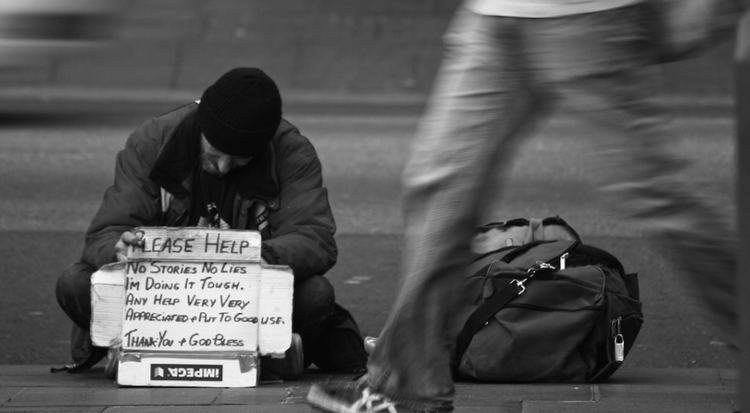
A person is considered to be homeless in Australia if they:
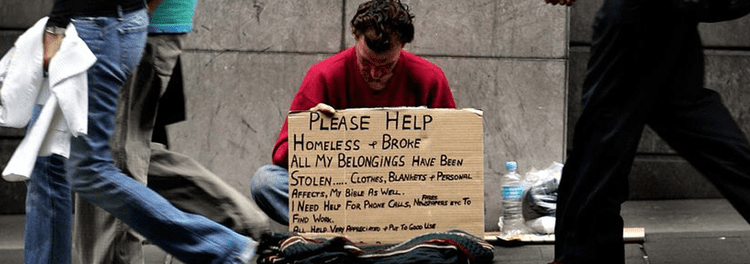
Homelessness in australia
2011 census homelessness figures
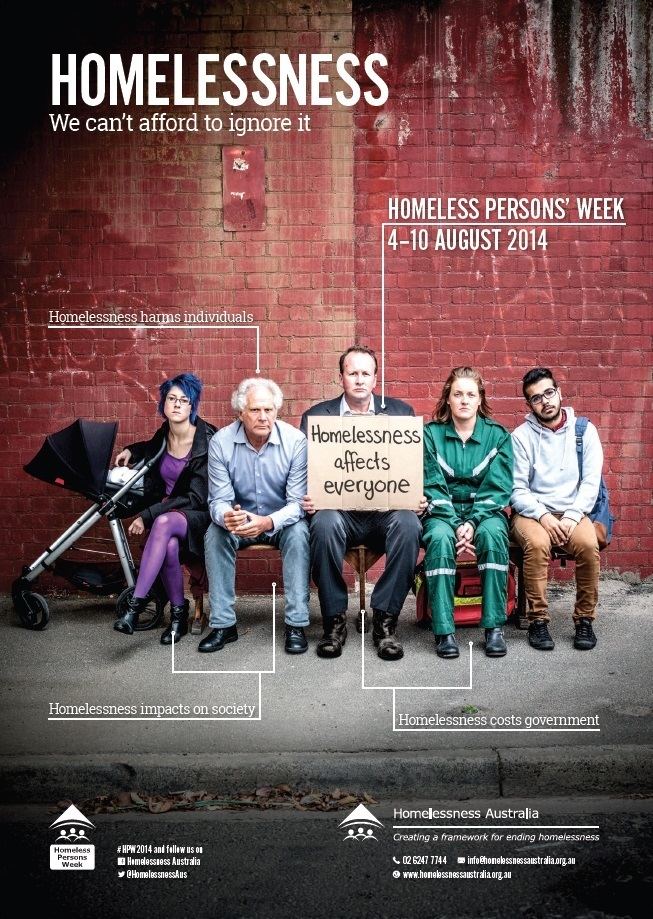
There were 105,237 people experiencing homelessness in Australia on census night in 2011. This equated to 1 in 200 Australians, and represented an increase of 17% from the 2006 census, with the rate of homelessness increasing from 45 per 10,000 to 49 per 10,000.
People who are homeless in Australia are classified into one of six categories. These are:
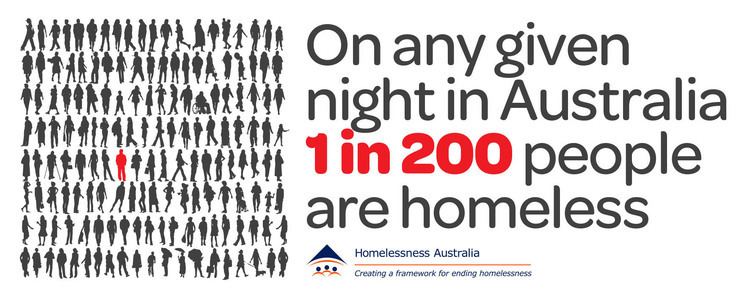
56% of people experiencing homelessness on census night were male and 44% female. Aboriginal and Torres Strait Islander Australians were over-represented in homelessness data making up 25% of the homeless population, compared to 2.5% of the Australian population. 30% of those experiencing homelessness were born overseas above the % of the Australian population.
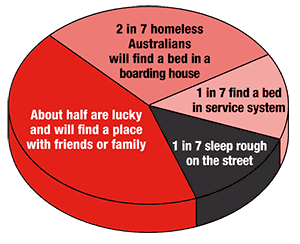
From 2006 to 2011 the number of people sleeping 'rough' decreased from 9% of the homeless population to 6%. There was also a significant increase (23%) in the number of people staying in homelessness services.
Causes
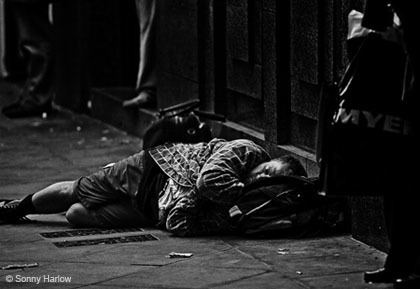
There are many causes of homelessness. The reasons for homelessness are many and varied and each individual's path to homelessness is different and unique. Some other reasons for homelessness are: addictions, exiting care (foster care system or prison system), barriers facing refugees, debt, disability, unemployment, lack of support, blacklisting, poverty, and being kicked out of home. Some of the current homeless population in Australia were previously in large-scale residential institutions for the mentally ill. Deinstitutionalisation of people with mentally illnesses began in Australia during the 1980s, and most now live in the general community.
Costs
It has been estimated that a single homeless person costs the government $30,000 per year.
The Road Home - Federal Government White Paper
The Road Home was launched by former Prime Minister Kevin Rudd in December 2008. This White Paper sets an ambitious target to halve homelessness by 2020 and offer supported accommodation to all rough sleepers who need it. Launching the White Paper, Kevin Rudd said, referring to the 105,000 homeless people in Australia "A country like this should not have this problem, so large and longstanding, without being addressed, It's time we had a decent solution to this problem that has been around for a long time."
The Road Home focuses future effort and investment into three strategies:
- Turning Off the Tap: Early intervention services to prevent homelessness.
- Improving and expanding services which aim to end homelessness: Ensuring that Services are more connected, integrated and responsive to achieve sustainable housing, improve social and economic participation and end homelessness for their clients.
- Breaking the Cycle: Ensuring that people who become homeless are able to quickly move through the crisis system into stable housing with the support they need so that homelessness does not recur.
Affordable housing
The Council of Australian Governments (COAG)'s National Affordable Housing Agreement (NAHA) subject to provisions of the Intergovernmental Agreement on Federal Financial Relations, defines and measures housing and homelessness services for the Commonwealth and the States and Territories. In 2008 Rudd announced that NAHA would "deliver more longer-term housing for Australians who are homeless, more public and community housing and build and renew run down and overcrowded housing for Indigenous Australians living in remote areas." NAHA's manadate includes a) social housing; assistance to people in the private rental market; support and accommodation for people who are homeless or at risk of homelessness; and home purchase assistance; b) (b) working towards improving coordination across housing related programs to make better use of existing stock and under-utilised Government assets and achieve better integration between housing and human services, including health and disability services; and c) reducing the rate of homelessness."
National Partnership Agreement on Homelessness (NPAH)
Since 2008, the National Partnership Agreement on Homelessness (NPAH) was formed to allow the Commonwealth Government to provide matching funding to hundreds of homelessness services. In response to the federal funding, states and territories typically match the Commonwealth’s contribution. The total annual NPAH funding is around $250 million per year which is directed to around 800 homelessness services around Australia.
In 2016, homelessness services across Australia began a #SaveNPAH campaign to ensure the Australian Government renews the funding package past 2017. The services stated that without the funding, services would be forced to cut back on essential programs and thousands of Australians would become homeless. The #SaveNPAH campaign succeeded in part, with the Australian government committing to a one year extension of funding.
State Government initiatives
In South Australia, the State Government of Premier Mike Rann (2002 to 2011) committed substantial funding to a series of initiatives designed to combat homelessness. Advised by Social Inclusion Commissioner David Cappo and the founder of New York's Common Ground program, Rosanne Haggerty , the Rann Government established Common Ground Adelaide building high quality inner city apartments (combined with intensive support) for "rough sleeping" homeless people. The government also funded the Street to Home program and a hospital liaison service designed to assist homeless people who are admitted to the Emergency Departments of Adelaide's major public hospitals. Rather than being released back into homelessness, patients identified as rough sleepers are found accommodation backed by professional support. Common Ground and Street to Home now operate across Australia in other States.
AskIzzy
Youth homelessness
In the mid-1970s, evidence began to emerge that the traditional homelessness population predominantly consisting of middle aged or older males was changing. Instead, younger people began emerging in surveys of the homeless population. This change is attributed to the disproportionately high unemployment rates among young people at the time, inadequate unemployment benefits (particularly for teens who had left school), burgeoning inflation rates and increasing housing and rent costs. This change in demographic increased the demands made on the non-government welfare sector to accommodate homeless youth.
According to the 2006 census, there were over 44,000 young people experiencing homelessness. This means that about 43% of the Australian homeless population are infants, children or youth under the age of 25. A particularly common form of youth homelessness in Australia is "couch surfing" whereby the person experiencing homelessness relies on the support of friends to sleep on their couch or floor. Relationship breakdown and family conflict are often cited as common instigators of youth homelessness.
Youth Homelessness Matters Day is an annual event run across Australia that highlights youth homelessness and associated issues.
Youth refuges
Youth refuges started appearing in Australia in the 1970s as a community based response to youth homelessness.
Post traumatic stress disorder and homelessness
A 2006 University of Sydney study of Sydney's homeless found a very high incidence of Post Traumatic Stress Disorder (PTSD) amongst the homeless.
